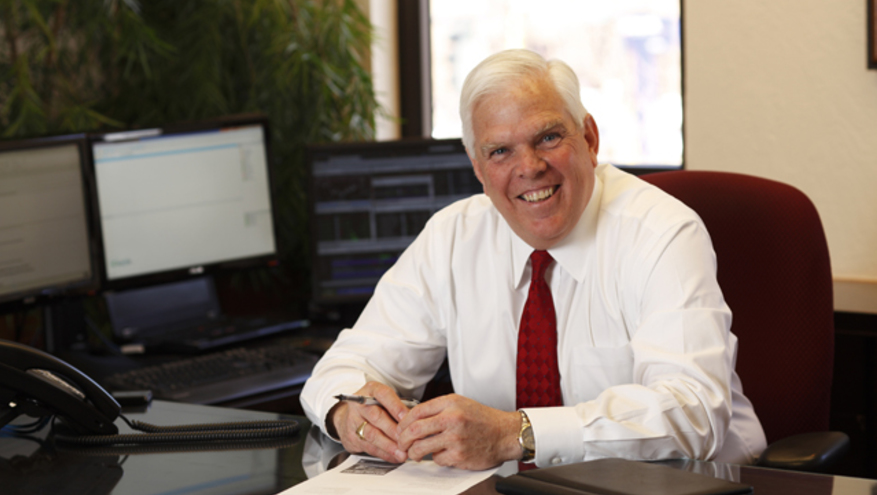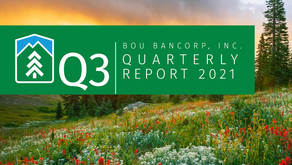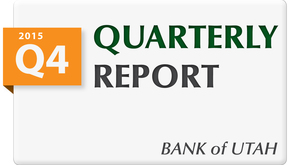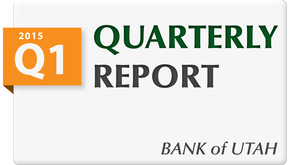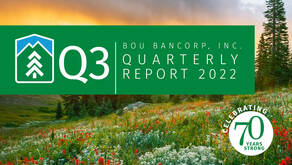President's Message
On behalf of BOU Bancorp Inc., (BOU) the holding company of Bank of Utah (Bank), I am pleased to report a cash dividend for the third quarter of 2015 of .60 per share. At book value, the dividend represents approximately 2.8 percent annualized cash return.
When deciding where and how to grow a profitable business, it is important to choose the markets that will be most advantageous to produce a successful outcome. We believe that one of the reasons for the Bank’s current and continued growth is due to the markets that management has chosen to focus our resources.
Bank of Utah’s assets are primarily invested in the state of Utah. As you are probably aware, Utah is one of the fast growing states. Utah’s population as of 2014 was 2,940,000. That number is expected to increase by over 369,000 in the year 2020 and by 2030, nearly 4 million people will call Utah home. This growth is coming in two sources. First, a structurally high birthrate, which is among the highest in the nation, according to the CoStar Group. Second, Utah’s outstanding economic performance (based on findings of the Governor’s Office of Management and Budget) as indicated by:
- Utah gained 50,000 new jobs between May 2014 and May 2015, an increase of 3.8 percent (1st in nation)
- Utah’s employment base has added 202,000 jobs the beginning of 2010 (2nd strongest in the nation)
- Utah’s unemployment rate is the 3rd lowest in the nation (3.5 percent as of May 2015)
- All of Utah’s major industrial sectors, except mining, posted employment growth over the last 12 months.
As a leader in the local financial industry, the Bank has been exceeding the average growth rate of banks nationally. The Bank’s year over year growth rates are shown below:
- 9 percent increase in deposits
- 9 percent increase in stockholder equity
- 10 percent growth in total assets
- 16 percent loan growth
- 25 percent increase in net income
We anticipate becoming a $1 billion bank in the very near future. With that size increase, comes complexity, particularly in IT security. To increase our ability to protect the Bank and our clients, we hosted seminars to educate our customers about how to protect themselves on the internet. We have also promoted Brian Stevens, former controller at the Bank, to lead our IT department in meeting these challenges and to give our customers the tools they need.
Finally, we have added three new board members that have vast amounts of experience in the community and the business world. They are Marlin Jensen, Steve Petersen and Ben Browning. They will give us a greater perspective and insight on how to serve our customers now and into the future.
Since 2007 there are now 23 percent less banks in the United States (1,800 fewer institutions). Our goal is to be not only your Bank, but your children’s Bank well into the future.
Douglas L. DeFries
President
Q3 Financial Analysis
Commercial Lending: Commercial loan growth is 13.7 percent YTD. Notwithstanding the growth in loans outstanding, credit quality remains exceptional as measured by the .52 percent ratio of non-accrual loans and ORE to Tier 1 Capital and Allowance. Quarter end loan delinquencies are 0.0 percent of the total loan portfolio. The Bank focuses on building a categorically diverse loan portfolio without customer concentration.
Mortgage Lending: An excellent source of earnings has come from our mortgage group for the past four years. The Bank has already funded more loans in the first nine months than in all of last year. Though the market may slow nationally, we believe our formula for lending will keep us competitive locally as we continue to add quality loan officers and operation experts.
Trust Services: Growth has been constant year over year in the trust department. Corporate trust continues to add new clients world-wide. Personal trust employees ensure proper account administration and provide a high level of customer service. We also have the advantage of decision making at a local level.
Deposits: Since 2013, the Bank has had consistent market growth in deposits. This growth has come from a combination of in-house referrals, branches and increased lending that generates additional deposits.
Talking Points
BOU continues to be strongly capitalized compared to our peers. Tier 1 Capital to quarterly average assets was 13.29 percent compared to our peers at 10.70 percent, as of the end of the third quarter 2015. All regulatory capital ratios exceed the “well capitalized” thresholds. In addition, BOU has a very high-quality capital mix, comprised mostly of common equity.
Asset quality continues to exceed that of our peers. Our peer group has 1.41 percent in past due loans and 10.13 percent in ORE and non-accrual loans to Tier 1 Capital and allowance. BOU has 0.0 percent in past due loans and .52 percent in ORE and non-accrual loans to Tier 1 Capital and allowance. These ratios reflect a strong overall market and our attention to detail in loan underwriting and portfolio management.
Non-interest income sources continue to support the Bank’s earnings. Non-interest income generated from our mortgage, corporate trust and other departments have generated over $15.6M of the $42M gross revenue year to date. This continues to be a positive addition to traditional community bank earnings that is much more weighted to net interest income.
Deposit growth has accelerated over the past three years. These deposits are being deployed mainly into commercial lending. This has helped to improve profitability for the Bank significantly.
